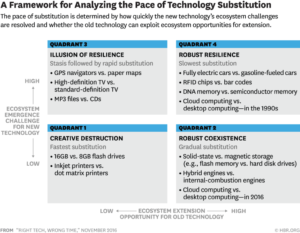For the new technology, the key factor is how quickly its ecosystem becomes sufficiently developed for users to realize the technology’s potential.In the case of cloud-based applications and storage, for example, success depended not just on figuring out how to manage data in server farms, but also on ensuring the satisfactory performance of critical complements such as broadband and online security.
For the old technology, what’s important is how its competitiveness can be increased by improvement in the established ecosystem.
 There are four possible scenarios for new technology’s ecosystem can overcome its emergence challenges relative to the rate at which the old technology’s ecosystem: creative destruction, robust resilience, robust coexistence, and the illusion of resilience.
There are four possible scenarios for new technology’s ecosystem can overcome its emergence challenges relative to the rate at which the old technology’s ecosystem: creative destruction, robust resilience, robust coexistence, and the illusion of resilience.
Creative destruction:When the ecosystem emergence challenge for the new technology is low and the ecosystem extension opportunity for the old technology is also low, the new technology can be expected to achieve market dominance in short order.
Robust coexistence:When the ecosystem emergence challenge for the new technology is low and the ecosystem extension opportunity for the old technology is high, competition will be robust.
The illusion of resilience:When the ecosystem emergence challenge is high for the new technology and the ecosystem extension opportunity is low for the old technology, not much will change until the emergence challenge is resolved—but then substitution will be rapid.
Every innovator wants to end up in quadrant 1 so that it can play the classic creative-destruction game. But there are different paths for getting there. A hypothesis that predicts a transition path from Q4 to Q3 to Q1 is a bet on the exhaustion of the old technology. For an innovator, that would mean focusing on aligning the new-technology ecosystem without great concern for extending a performance advantage.
Source:https://hbr.org/2016/11/right-tech-wrong-time


